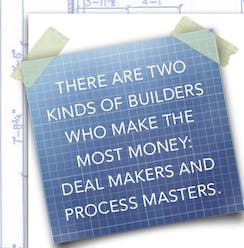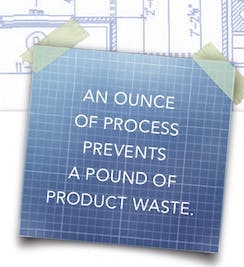Listen Up Home Builders, It’s All About the Process
A basic truth, which most people learn the hard way, is an ounce of prevention is worth a pound of cure. Likewise, it is a basic home building principle that an ounce of good process prevents a pound of product waste and the labor that goes with it. While this truth is inarguable in practice, we’ve not yet reached the tipping point for this level of thinking in our industry.
If you doubt me, think about the last time you were compelled to find some cost savings. Where did you look? Straight away, most builders focus on one of two areas: house cost or overhead. In the house cost category, they launch an immediate search for opportunities to negotiate better prices for labor and materials. (Good luck with that approach in today’s market.) In overhead, they almost always start with an effort to eliminate jobs. There are indeed significant savings opportunities to be found in being more efficient with trade labor, materials, and our own people, but that isn’t how you find the real cost savings. The route to the margin you seek is through process.
Home Building Deal Makers vs. Process Masters
In my last two articles, we established that process is critical to bridging the bulging margin gap that results from growing sales volume without sufficient rise in sales price to cover the cost increases that home builders are encountering this year in every budget category (April and May). In nearly three decades in home building, working with more than 200 builders, I’ve concluded that those who make the most money predominantly fall into two categories: the Deal Makers and the Process Masters.
Becoming a Process Master, however, is something that all can aspire to. It’s one of those concepts that’s usually understood intellectually but glossed over in day-to-day operations because people are unaware of the impact that process failure has on not just profit, but on the morale of the entire company.
When I began writing this article, I’d intended to provide a more in-depth explanation of the essential processes that builders must master to rise to the top and stay there. Yet I kept coming back to this persistent problem of intellectual understanding with no behavioral change. Then I recalled the incident in my past that fully woke me up to the impact of process failure on home building. It hit me like bricks falling from a 15-foot scaffold, and it changed my thinking forever.
What Door?
I had decided to drive by a project on a Saturday morning because it was quieter then and I could walk around and study what the builder who hired me was building and how he was building it. I explored a few home sites in various stages of construction, and then I saw the hopped-up Ford Ranger pickup belonging to Jason, a young, high-energy assistant superintendent I’d met just the day before. I wondered what he was up to on site on a Saturday, and since I didn’t see him in front, I walked down the near side of the house. I was clear around the back and starting up the other side when I saw him. With a tape measure and a carpenter’s square, Jason was tracing a rectangle on the side of the house about 20 feet back from the garage entrance. He was so intent on his work that he didn’t notice me approach. It took only a few moments for me to realize that he was neatly laying out the location of a service door.
My energetic “Good morning, Jason!” startled him so much that he dropped his square. Then, noting my interest in what he was doing, he said, “OK, you caught us. The jig is up!” He then explained how Friday, at about 4 p.m., the new homeowners were just finishing their final walk when the husband said, “Wait! Where is my service door?” Jason’s boss was a late 20-something, highly respected field superintendent named Ted, who I had also met the day prior. This was the first that Ted had heard of a service door, but with the wife nodding sincerely, he was confident that yes, the couple had ordered the optional service door and that yes, it had been missed. Ted’s head was spinning and he knew they were supposed to close Tuesday morning. Sure, he would have to trace it back, check the paperwork, make absolutely sure that the service door was on the original selections, but his gut said this was legit and he stammered, “I am so sorry this happened. We will get on it right away and you’ll have your service door!” The homeowner’s final comment was, “I’m not sure we should close until it’s in, should we?”
Ted was confident he could convince the homeowners that yes, they could close without the door being in, but his company’s president had been on a major campaign, emphatically insisting that “we will close no home that is not 100 percent complete with exceptional quality.” Ted didn’t want to be the one who let the president down, so he replied to the homeowner, “We will have this installed by the end of Monday, sir!"
Calling in Favors to Get the Job Done
While Jason carefully drew out the door on the house, Ted was back at the construction trailer trying to get everything for the door lined up. First he called the design center, explaining that he realized how busy they are on Saturday but that he had to know if the service door was specified in the options and selections. Ten minutes later they called back with the answer: yes. Obviously, that selection had been lost somewhere between the design center and Ted’s start package, but how or why wasn’t the issue right now.
Ted made a list of everyone required to get the door in and became painfully aware of just how many supplier/trade favors he would have to call in to get this done. He was about to begin the arduous task of calling every supplier and trade he needed when he thought, “The stoop! That can’t wait until Monday.” Ted called Jason and asked him to run down the street to where the flatwork crew was laying sidewalks that day—and beg. Could they form up that stoop and pour it today with concrete left over from the sidewalks? It might work. Back to the list.
Ted needed the sider to come early Monday and carefully cut out an opening. Meanwhile, the drywaller could remove the drywall on the inside at the same time. He’d have the mason come by at 9 a.m. to cut out the waist-line brick but man, that would have to be done perfectly. Then the electrician could come at 10 a.m. to cut the wire to the coach lights that, of course, ran right through the door location. He’d have to run the wire up and over the door, then run a switch and cut in a box for the service light that code required. Don’t forget the jelly-jar fixture!
In truth though, most of the damage is done by the slow, relentless eating away of time and energy under the unremitting abuse inflicted by substandard systems.
Worst of all though, the gas line ran right down that wall as well, the meter being just a few feet from the new door, toward the front of the house. The plumber was one of Ted’s best trades and he knew he could count on him. Just be thankful, thought Ted, that the meter itself doesn’t have to be moved. But run a gas line up and over the door? Ted had never seen it done … let’s hope the inspector doesn’t wander by … and oh, that means even more drywall removed. Then the framer can come at noon to remove the studs and frame out the new door opening. Gotta have those dimensions perfect. Get drywall back at 2 p.m. and use that special mud that dries almost instantly.
Now a big sigh from Ted, grateful the homeowners had decided to order the insulation and drywall option with fire tape only, unpainted. What about the insulation? He’d ask the framer to pull it and Jason would repack it after the plumber and electrician had finished. Ted wondered ... what did he miss? The trim! Both inside and out, and the trim carpenter, who he’d ask to install the door and hardware. Let’s see … if the trim carpenter was there by 3:30 p.m. … Now Ted had to call the lumber company to see if he could get the door there by then.
Losing Money and Homebuyer Goodwill. Who's Sorry Now?
Let’s leave Ted there for now, but I’m confident you get the picture: One item goes missing between options and the start package, and the next thing you know—between Ted, Jason, 10 suppliers, trades, and admin—what do you lose? Add everything up and the bill exceeds $2,500, not counting the cost of Ted and Jason’s time. It’s not just the hours spent on the rework, it’s also the lost benefit of what would have been gained had those hours been spent on something productive. This also applies to the suppliers, trades, and admin people. All in, it could cost $5,000 in total impact.
And what about the homeowners? A couple that was happy with their home is now on high alert, wondering what else may be overlooked. What will they tell their friends? Will they praise their builder and their new home, or will they tell the tale of the missing door and caution other potential buyers to be careful?
While we can’t put a number on this, we do have to keep it in the equation. As quality and operations guru Dr. W. Edwards Deming stressed, some of the most important numbers for management are unknown and unknowable.
In truth though, most of the damage is done by the slow, relentless eating away of time and energy under the unremitting abuse inflicted by substandard systems. A plan goes out to the truss company without the optional bonus room indicated and the wrong trusses show up on the job. A day lost for the framers, a truckload of trusses scrapped and returned to the plant with the cost of loading, unloading, rebuilding, and loading again. Pressure from the top causes estimating to remove one cube of brick from five models, which actually works—for two of them. Time lost. Extra trips. Requests requiring three sign-offs that could easily be handled with one. All that paperwork going back and forth between the field offices could be done electronically and half of it could be eliminated up front. The report that accounting dutifully works through lunch to generate by 2 p.m. each Monday rarely is reviewed by the CFO before Wednesday or Thursday, if at all.
Bad process eats away at the connective tissue of a company and is a major factor in employee turnover. At some point, your people just aren’t having fun anymore. (Cue Tina Turner singing “We Don’t Need Another Hero.”)
Our list of Essential Home Building Processes has expanded from last month by two. I suggest your team study these and resolve to make just one significant improvement in each process this year.
12 Essential Home Building Processes
1. Land/lot selection: matching land with what you build well and profitably
2. New community startup: from land purchase through opening the first model
3. Product design: from conception through fully detailed working drawings
4. House bid package: including specifications, options, contracts, and scopes of work
5. Sales and marketing process: including options, selections, and design center (if applicable)
6. House start package: 100 percent accurate, all details of exactly what goes into each house
7. Supplier and trade development: securing and sustaining top trades and crews at a competitive price
8. PO/VPO process: accurate, efficient, responsive, with minimal variance
9. Building schedule: accurate and predictable for suppliers, trades, and customers alike
10. Field construction and quality: including site management, material management, QA
11. Homebuyer management: from contract through warranty
12. Culture/people development: building a great workplace with productive people
I’ll delve more deeply into these in my next column. When we truly reach process mastery, home building will change forever. We’ve watched it happen in other industries, such as automotive, that were every bit as skeptical and bound by tradition as ours. Although there have been marginal improvements in materials during that period, ask anyone who has lived through it on the inside of the industrial manufacturers and they’ll tell you exactly what we have concluded about home building: It’s all about the process.



